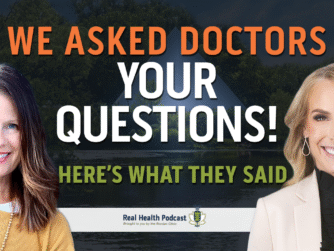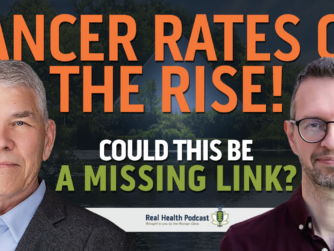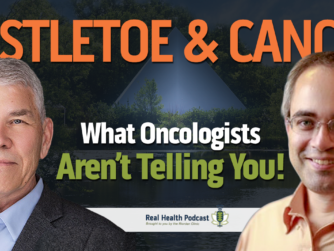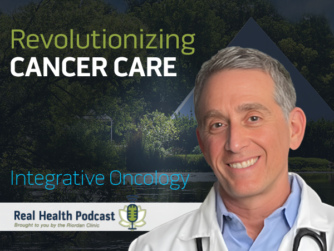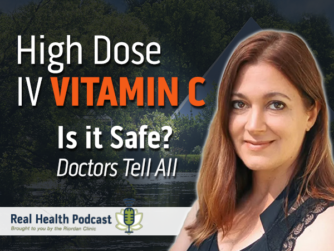What if the treatment they said was impossible… actually worked? In this inspiring episode of The Real Health Podcast, Dr. Ron Hunninghake, MD sits down with Blake Benton to discuss his family’s incredible journey with stem cell therapy for Duchenne muscular dystrophy. Learn how Coming Together for a Cure, a nonprofit founded by the Benton family, is now helping hundreds of families access life-changing treatments!
Thanks to This Episode’s Sponsor
Riordan Clinic Nutrient Store: https://store.riordanclinic.org/
Links
Blake Benton:
•Coming Together for a Cancer Cure: https://www.ctfac.org/
•Watch The Sunshine Dreamer Documentary: https://www.ctfac.org/the-sunshine-dreamer-documentary
Dr. Ron Hunninghake, MD: https://riordanclinic.org/staff/ron-hunninghake-md/
Learn more about Riordan Clinic: https://riordanclinic.org/
Interested in becoming a Patient: https://riordanclinic.org/request-an-appointment/
Disclaimer: The information contained on the Real Health Podcast and the resources mentioned are for educational purposes only. They’re not intended as and shall not be understood or construed as medical or health advice. The information contained on this podcast is not a substitute for medical or health advice from a professional who is aware of the facts and circumstances of your individual situation. Information provided by hosts and guests on the Real Health Podcast or the use of any products or services mentioned does not create a practitioner-patient relationship between you and any persons affiliated with this podcast.
Read the Transcript
00:00:00:00 – 00:00:17:03
Narrator
This is the Real Health podcast brought to you by Riordan Clinic. Our mission is to bring you the latest information and top experts in functional and integrative medicine to help you make informed decisions on your path to real health.
00:00:17:06 – 00:00:42:02
Ron Hunninghake, MD
So welcome everyone. I’m Doctor Ron Hunninghake, and I’m the chief medical officer here at the Riordan Clinic. And we’re pleased today to have, as our guest, Mr. Blake Benton. Blake, so nice to have you here. He is the head of the strategic initiative for coming together for a cure, which is a nonprofit organization based here in Wichita, Kansas.
00:00:42:05 – 00:01:06:27
Ron Hunninghake, MD
And, what we’re going to be talking about is what they do. So, welcome. And, I want to mention that we also want to kind of weave in how your organization fits in with our history here at the Riordan Clinic. So but first of all, tell me a little bit about about this, ‘Coming Together for a Cure’.
00:01:07:00 – 00:01:38:08
Blake Benton
So that’s the initially was the name of a fundraiser that my brother and our family came up with in 2008 after he started receiving mesenchymal stem cell therapy for Duchenne muscular dystrophy. And he we discovered he was the first person in the world with Duchenne to be successfully treated with stem cells and that made a, you know, an enormous difference and changed the whole trajectory of our family and and his health and our lives.
00:01:38:08 – 00:02:00:02
Blake Benton
And so over time, we, evolved. And now it’s a nonprofit that has helped hundreds of families around the world, and it’s helping spearhead clinical trials. And, providing countless resources to families that otherwise were unaware of or just, hadn’t afforded the opportunity.
00:02:00:04 – 00:02:31:11
Ron Hunninghake, MD
Yeah. So so to bring in the connection with the Riordan clinic, tell us a little bit, Neil Riordan has been instrumental in, the founding of your company and and his research and the research that he, has done with mesenchymal stem cells, which are basically stem cells that, well, replicate and heal, organs within the body.
00:02:31:11 – 00:02:44:07
Ron Hunninghake, MD
It’ll repair organs within the body. And so, so Neil has been very much involved with that. But, your, your version of how Neil, has played a role in your company.
00:02:44:09 – 00:03:15:28
Blake Benton
So my older brother, Ryan, when he was three years old, he was diagnosed with Duchenne muscular dystrophy, which is a terminal muscle wasting disease that affects roughly 300,000 people in the US. Most of the time, it’s boys that are affected. And around ten years old, boys lose the ability to walk. And typically around late teens or early 20s, the disease starts to become very critical and starts to look a lot like ALS.
00:03:16:01 – 00:03:46:12
Blake Benton
And then, it’s terminal. So most everybody passes away by mid 20s. Thankfully, Doctor Riordan grew up down the street from my dad out here in East Wichita, and they went to high school together at East High. And as, Neil’s Neil Rirodan, Doctor Hugh Riordan’s son, had done cancer research with his dad at the Riordan Clinic.
00:03:46:12 – 00:04:23:13
Blake Benton
And then that led him to stem cell research. And he had came across a study of, of a somebody that received stem cells for Becker’s muscular dystrophy. And they ended up in treating somebody with Beckers down at his clinic in Costa Rica. And the results were just tremendous. And so he called my dad and said, I think this is something that finally, you know, might be able to be an option for Ryan and it always stuck out to Neal because his daughter, his his first born, was born within about two weeks of Ryan.
00:04:23:13 – 00:04:55:29
Blake Benton
And so as Ryan grew and his daughter grew, their their health just took, you know, drastic turns. And so, it we’re just extremely fortunate that he always kind of had us in the back of his mind as someone that he wanted to, you know, hopefully be able to help some day. And so anyways, when he called my dad in 2008, you know, Ryan had just that same day, received the call from the local MDA office that, one of his friends with the same disease had died.
00:04:56:02 – 00:05:27:25
Blake Benton
So think about the the drastic comparisons of your Ryan and our family’s prayers were answered the same day that other kids and families were having the worst day of their lives. And so we made the most of it. And we prayed, and we realized we had no reason not to put our faith in this. And Doctor Riordan and so, Ryan and my dad and his best friend went down to Costa Rica, and the cells allowed him to regain strength that he had never had before.
00:05:27:27 – 00:05:50:16
Blake Benton
Because when you and I, we, you know, if we, try to do a push up, our muscles will feel sore. And because they’re breaking down. But for Duchenne muscular dystrophy, it’s caused by a lack of a functional protein called dystrophin that’s necessary to protect and maintain muscle. And so when he would try to do any sort of exercise, he’d never feel that.
00:05:50:16 – 00:06:14:00
Blake Benton
And his body just had constant atrophy. Well, after the first round of stem cells, we would exercise and he would feel sore and all the sudden he could pick his neck up and regain trunk strength in ways that maybe he had lost a year or two before he all of a sudden had these motor functions regained. And, so it’s just phenomenal.
00:06:14:00 – 00:06:40:00
Blake Benton
And he was kind of a guinea pig because Neil was still discovering really the best ways to administer this. And so Ryan had received 35 intramuscular injections and throughout his major muscle groups. And from there they learned you know, how you need to. Then you know, better practices to utilize Evie instead of having to do direct and or muscular all the time.
00:06:40:02 – 00:06:51:27
Blake Benton
And, so Ryan was kind of a pincushion and truly a pioneer for now. So many other patients that, have been able to benefit from this therapy. Yeah.
00:06:51:29 – 00:07:30:00
Ron Hunninghake, MD
So the the Neil’s father, Doctor Riordan he Riordan was the founder of the center for the Improvement of Human Functioning. So he was always about trying to help people improve their functioning. And certainly, Neil, being the son and being an incredible scientist, I mean, I Neil’s probably one of the brightest minds that I know. And, he, he also inherited that curiosity that his dad had that led him to start the Riordan clinic.
00:07:30:00 – 00:07:59:20
Ron Hunninghake, MD
And what we do is we do various, regenerative type things because a lot of what people are experiencing these days are degenerative illnesses now. Not not necessarily genetic, degenerative, but, lifestyle degenerative. You know, dietary factors, environmental toxins, poor sleep habits. These all all of these things indirectly lead to a kind of degeneration of the health of the body.
00:07:59:22 – 00:08:03:18
Ron Hunninghake, MD
So with your with your brother, that’s he’s your younger brother.
00:08:03:20 – 00:08:06:17
Blake Benton
Ryan. And my older brother who’s seven years older than me.
00:08:06:17 – 00:08:19:12
Ron Hunninghake, MD
Oh, you’re the younger brother. Okay. So with him, genetically speaking, he was missing, a factor that would allow him to to make this this one component necessary for muscle health.
00:08:19:14 – 00:08:26:24
Blake Benton
Yeah. And this spontaneous gene mutation. Thankfully, I didn’t have it because it’s spontaneous and it wasn’t hereditary.
00:08:26:24 – 00:08:55:16
Ron Hunninghake, MD
Yeah, yeah. And so with stem cells, basically stem cells are what the body uses to repair injuries within the body. And in this case it’s repairing a genetic, shall we say, injury. And it’s having a dramatic effect. And it’s, it came about because of a willingness to look for answers, because sometimes people say, well, it’s just it’s just too bad, you know, it’s just, it’s genetic.
00:08:55:16 – 00:09:17:17
Ron Hunninghake, MD
There’s nothing we can do. A lot of people sometimes say that with their chronic illnesses, they feel like they’ve gotten to the end of their road and no one’s been able to help them. And so they kind of give up hope. But oftentimes with a look deeper to the underlying causes, there can be answers that are found. And so it takes that inquisitive spirit.
00:09:17:24 – 00:09:30:18
Ron Hunninghake, MD
But it also took your family’s willingness to go out on a limb and, see if this really worked for him. Now, you you’ve actually gone on to make a movie about this, this whole story, is that right?
00:09:30:20 – 00:09:51:02
Blake Benton
Yeah. So, you know, shortly after Ryan, we realized how it worked. He said, let’s start a, a fundraiser and start giving back. And this was on 2008. So this was when the social media was getting off the ground, and we started telling our story online and doing these annual fundraisers, and people started reaching out from all over the world.
00:09:51:04 – 00:10:20:16
Blake Benton
Well, over this time period, we started helping countless families understand proper education, get connected to, trustworthy and reliable resources as they, you know, pursued this type of therapy on their own. And we maintained relationships and started recording interviews and took a lot of video testimonials as people wanted to advocate for this, to to show how it can be a new option for others.
00:10:20:18 – 00:10:58:29
Blake Benton
And so in about 2018, Ryan said, you know, why don’t we package all this together into a narrative story that, can hopefully inspire and motivate and, create, create the opportunity for others to take action. And so we spent countless hours over the last five years or so to put together this film that’s now 80 minute, feature documentary that we’ve, screened and over in Rome, Italy, at film festival there as well as a film festival here in Wichita.
00:10:58:29 – 00:11:25:02
Blake Benton
And then we’ve got other festivals, lined up throughout the rest of the year. But it’s, you know, sort of includes stories of families that we’ve supported from Australia to the remote parts of Europe to big and small cities in the US. And it’s people that took a risk. And but it’s calculated, you know, they realized the standard of care wasn’t working.
00:11:25:07 – 00:11:52:26
Blake Benton
And the the line and obstacles necessary to access current clinical trials in the US are, just unreasonable. And so they took matters in their own hands as safe as possible and, now have amazing testimonials to share, and we’re happy to help them, happy to help give them a platform to do that through.
00:11:52:28 – 00:12:09:28
Ron Hunninghake, MD
One of Doctor Riordan’s. The older docs ruins favorites saying is was while they were saying it couldn’t be done, someone did it. And so that’s kind of what you guys are doing, along with Neil Riodan and, this whole organization. And so what was the name of the movie The Sun?
00:12:10:01 – 00:12:29:08
Blake Benton
It’s called The Sunshine Dreamer. And you know the name of that it comes from. That was the name of my brother’s, band. His rock. Oh, yeah. And so that’s a theme that we want to make very clear, is that it’s one thing to have the cells be able to help improve your health, but it’s another thing to make the most of that.
00:12:29:08 – 00:12:48:26
Blake Benton
And that’s what Ryan did every day. You know, he had a drive to get out of bed because he was so passionate about music and the community of friends that that attracted to him gave him so much energy and zest to take on each day, despite his body still falling apart on him. And so yeah, the name of his band is Sunshine Dreamers.
00:12:48:26 – 00:13:21:25
Blake Benton
They’re a lot like combination of the Beatles and Pink Floyd and, some, some of today’s like, indie music. But you know, the, the movies really kind of weaves his story from childhood to, very recent, just showcasing how you can make the most of life, especially if you can access this, this stem cell therapy that can allow you to fight back against your terminal chronic condition.
00:13:21:28 – 00:13:44:12
Ron Hunninghake, MD
We see that a lot here at the Riordan Clinic. I’ve been here 34 years, and we see people who have been to ten, 20 other doctors and they said, basically there’s nothing we can do, you know, for severe chronic degenerative illnesses. And, the idea we have is to look deeper, you know, look, look at other underlying causes.
00:13:44:15 – 00:13:59:04
Ron Hunninghake, MD
Keep your mind open. Be open to the possibility that there is a way to find your, your your, your health. Again. But sometimes you have to be a bit innovative and think outside the box in order to, to find it. Well, it’s really.
00:13:59:04 – 00:14:34:26
Blake Benton
Challenging, especially when the standard of care takes so long to evolve. And that’s what’s important in this film. We have a lot of subject matter experts from people that work in the industry of life sciences to scientists and other researchers that speak about the efficacy and the safety of the the cell based therapies. But then also some people from the lobbyist and the regulatory side, a state senator, that can explain the the regulatory frameworks that are currently prohibiting this therapy from becoming, widely available.
00:14:34:26 – 00:15:05:27
Blake Benton
And then what can be done to ensure that we can make it safe and available for as many people as possible? So it’s a it’s a really complex issue that, can can become very confusing. But we have done a very thoughtful job to make sure we’re trying to spell everything out as clear as possible, because we know that it it’s irritating how many times people come to us over the past 15 years and said, this sounds too good to be true.
00:15:05:29 – 00:15:18:04
Blake Benton
It’s like, well, we we know what you mean. Now we’re going to prove to you why it is true and what it takes to make it a true option for so many other families that are in dire need.
00:15:18:06 – 00:15:53:22
Ron Hunninghake, MD
So one of the words that Doctor Riordan came up with, and I know Neil Riordan knows it well, and and it sounds like this is a word that can be applied to your organization as well. Is that, doctor Riordan referred, and we still today we refer to our patients as co learners. And so the whole co learning word in concept is to bring, that person who’s needing help, up and bring the person this kind of offering help down a bit in order to understand the uniqueness of that individual.
00:15:53:22 – 00:16:18:19
Ron Hunninghake, MD
Because a lot of times in conventional medicine, there’s a disease and here’s a treatment and there’s another disease and here’s the treatment, whereas in illnesses that are not well, taken care of by conventional standards, oftentimes the path to improving that person’s functioning in that person’s wellness is unique to that individual. Maybe it could be nutritional, maybe it could be hormonal.
00:16:18:21 – 00:16:51:16
Ron Hunninghake, MD
Hormonal. This is cellular. Who knows? What are the things, psychological factors can be, play a role in and a person getting. Well, because many people come to us, they’ve been told there’s no hope. And if you give up hope, it’s kind of hard to really find an answer at that point. So if you can help instill realistic hope in people based upon science, based upon research, based upon measurement, and based upon the willingness to search for that answer, that can be a very powerful road back to wellness.
00:16:51:16 – 00:17:01:12
Ron Hunninghake, MD
And so that’s what you’re doing. And I, I’m I’m excited for your organization. I hope people listening will look you up. How would they how would they find you.
00:17:01:14 – 00:17:37:24
Blake Benton
So website is coming together for a cure org or the acronym Ctfac.org. You can also find us through the same routes on all major social media Facebook, Instagram, LinkedIn, YouTube. But mean you hit it on the head because it’s personalized and precision. Medicine, thankfully, is now starting to become more of a standard, and we want to be a starting point for families that are tired of tired of the status quo when they hear their initial diagnosis, or once they’ve tried every avenue and don’t know where to turn.
00:17:37:26 – 00:18:00:15
Blake Benton
They need to realize that there are alternative apps that need to stop being called alternatives. Right? And there’s a simple way to to learn about and how to access these. You just need a guide to help you get there. Right. And that’s what we can be. And we’re we’re looking for more strategic partners that we can align their specialties to the communities that we’re that we serve.
00:18:00:15 – 00:18:18:22
Blake Benton
And, have 15 years of representing because we know what their pain points are and we know what solutions exist, but they need help finding the bridge to make it, accessible and then giving them actionable steps to, to achieve those new resources.
00:18:18:24 – 00:18:36:27
Ron Hunninghake, MD
So perfect. That really explains it well. And I think that is the journey for a lot of people who feel hopeless with, with any kind of chronic illness, genetic ones or even the toughest. But now with this stem cell therapy, it looks like there’s some a ray of sunshine.
00:18:37:00 – 00:18:57:03
Blake Benton
That the sunshine dreamer is a perfect analogy, and we know that the light at the end of the tunnel is only getting bigger. And, we’re just thankful that everything has come really circle full circle right now. I mean, back at the place where it all started, thanks to Doctor Neil’s, dad here, a hue at the. Really?
00:18:57:05 – 00:19:27:26
Blake Benton
And, you know, where there’s a there’s enormous optimism and promise in what’s happening with current trends in the market and new, changes in the current administration, thankfully, is is looking very favorable upon what we are passionate and experienced with. And so, yeah, a lot of upside that we are thrilled to be able to be a part of.
00:19:27:28 – 00:19:34:22
Ron Hunninghake, MD
Like, thank you so much for being on our program and for all that you’re doing to instill hope in so many people. So keep up the good work.
00:19:34:27 – 00:19:36:19
Blake Benton
Thanks for having me. You bet.
00:19:36:22 – 00:20:05:12
Narrator
Thank you for listening to The Real Health podcast. If you enjoy this episode, be sure to subscribe and leave us a review. You can also find all of the episodes in show notes over at Real Health podcast.org. Also, be sure to visit RiordanClinic.org, where you will find hundreds of videos and articles to help you create your own version of real health.


